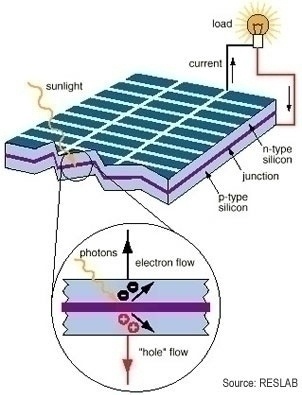|
|
















The Photovoltaic Principle
Solar photovoltaic's are arrays of cells containing a
material that converts solar radiation into electricity.
Each solar cell is made from one or two layers of semiconducting material, such as silicon. When solar energy (photons) reaches each cell, it creates an electric field across the layers. The stronger the sunlight, the more electricity is produced, but solar photovoltaic´s can still generate energy in overcast conditions.
The sun is and will be a reliable source of energy for the foreseeable future. A little over half of the total solar energy passes through the atmosphere to reach the Earth's surface. This energy flux has an average power of 89,000 Terawatt (1 TW = 1012 Watt).
Photovoltaic solar cells produce energy in a reliable solid-state configuration - without moving parts - and are virtually maintenance free during their expected lifetime of over 40 years.
Each solar cell is made from one or two layers of semiconducting material, such as silicon. When solar energy (photons) reaches each cell, it creates an electric field across the layers. The stronger the sunlight, the more electricity is produced, but solar photovoltaic´s can still generate energy in overcast conditions.
The sun is and will be a reliable source of energy for the foreseeable future. A little over half of the total solar energy passes through the atmosphere to reach the Earth's surface. This energy flux has an average power of 89,000 Terawatt (1 TW = 1012 Watt).
Photovoltaic solar cells produce energy in a reliable solid-state configuration - without moving parts - and are virtually maintenance free during their expected lifetime of over 40 years.














